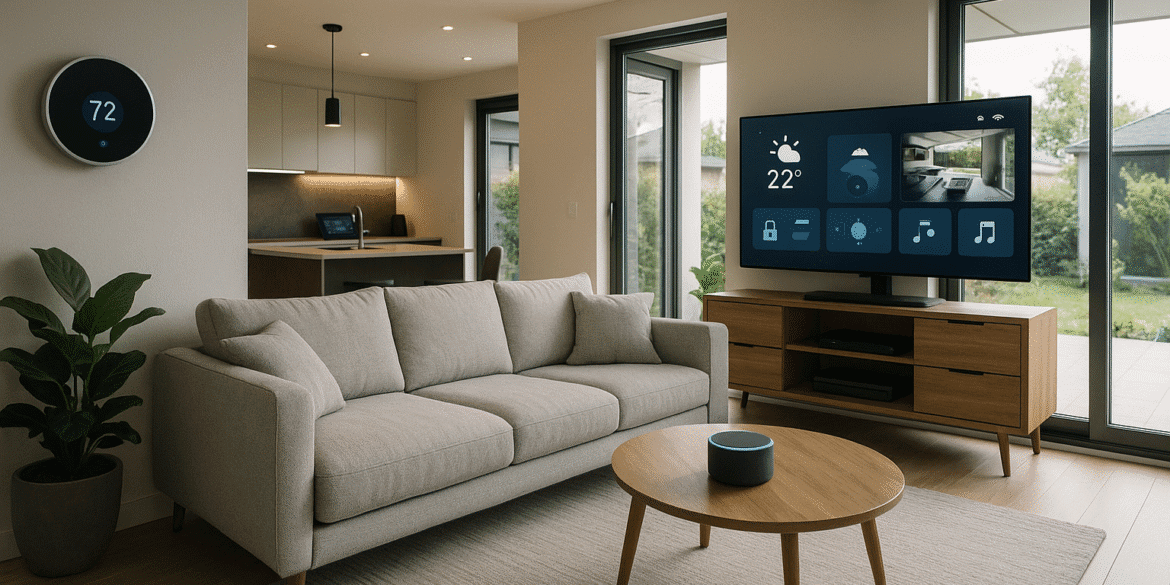The Rise of AI-Powered Home Automation
The foundation of a modern smart home is its ability to learn and adapt to the needs of its residents. AI-powered systems, such as smart thermostats, lighting, and security systems, are taking automation to the next level by analyzing user behavior and making decisions based on patterns.
One of the most popular AI-driven smart home devices is the Nest Learning Thermostat. This device not only adjusts the temperature based on the time of day but also learns the habits of the homeowner, ensuring the house is always at the optimal temperature while minimizing energy waste. According to a recent study by Energy Star, smart thermostats can reduce heating and cooling bills by up to 10-15%, making them a popular choice for homeowners looking to cut costs.
“AI is revolutionizing the way we think about home management,” said Andrea Lee, a product manager at Google Nest. “Our smart thermostat doesn’t just adjust the temperature—it understands your preferences and can even suggest energy-saving tips based on your lifestyle.”
Voice-Controlled Devices: Making Homes More Interactive
Voice assistants like Amazon’s Alexa, Google Assistant, and Apple’s Siri have become staples in smart homes. These voice-controlled devices enable homeowners to perform a range of tasks with simple voice commands—from adjusting the thermostat and turning on lights to ordering groceries and setting up reminders.
One of the latest innovations in this space is the integration of voice assistants with more household devices, such as refrigerators, washing machines, and even coffee makers. Imagine waking up and having your coffee ready, your lights automatically adjusted to your preferred brightness, and your home security system activated—all through a simple voice command.
For instance, in suburban Atlanta, homeowner Rachel Simmons has integrated her home automation system with Alexa. With the help of smart sensors and AI, Alexa can adjust her home’s lighting, play music, or even start her robot vacuum cleaner when she asks.
“It’s made my life so much easier,” said Simmons. “Instead of running around turning off lights or adjusting the temperature, I just ask Alexa, and it’s done. It’s all about convenience and efficiency.”
Smart Security Systems: Protecting Your Home with Intelligence
Security has always been a top priority for homeowners, and smart security systems are now offering unprecedented levels of protection. With AI-enhanced cameras, motion sensors, and smart locks, homeowners can monitor and secure their properties in real time from anywhere in the world.
For example, companies like Ring and Nest have introduced smart doorbell cameras that provide high-definition video feeds and motion alerts directly to your smartphone. These cameras can identify familiar faces and even detect suspicious activity, sending notifications to homeowners instantly. Some systems also offer facial recognition and AI-powered analysis, which can differentiate between a person, pet, or package.
In addition to cameras, smart locks allow homeowners to control access to their homes remotely. You can unlock the door for a guest, set up temporary access for a service provider, or even check if the door is locked—all via your smartphone. In fact, smart locks are becoming increasingly popular in high-tech neighborhoods, with more homeowners opting to replace traditional keys with digital ones.
“Smart security gives me peace of mind,” said Chris Patel, a homeowner in Los Angeles. “Whether I’m traveling for work or just at the office, I can always check on my home and ensure everything is secure.”
Sustainable Living: Smart Homes and Energy Efficiency
Sustainability is a growing concern for many homeowners, and smart home technology is helping reduce energy consumption and carbon footprints. From smart lighting systems that automatically turn off when not in use to solar-powered home automation systems, there are now countless ways to make a home more eco-friendly.
One example is the integration of solar panels with smart home technology. Companies like Tesla and Sunrun have made it possible to combine solar power generation with smart home energy management systems. These systems can monitor energy usage, optimize power consumption, and store excess energy for later use, making it easier for homeowners to reduce their reliance on grid electricity.
Additionally, AI-powered appliances, such as refrigerators and washing machines, can adjust their settings based on real-time energy consumption data. For example, a smart washing machine can decide the most energy-efficient cycle based on the load size, or a smart fridge can notify you when it’s time to adjust its temperature to save energy.
“Smart homes are the future of sustainability,” said Linda Gray, an architect specializing in green design. “By integrating solar power with energy-efficient home automation, homeowners are not just saving money—they’re reducing their environmental impact.”
Smart Appliances: Convenience and Efficiency in the Kitchen
The kitchen has become one of the most intelligent rooms in the house. Smart refrigerators now offer features such as inventory tracking, recipe suggestions based on what’s inside, and even the ability to order groceries directly from the fridge. Smart ovens and stovetops can be controlled remotely, allowing homeowners to preheat the oven or adjust cooking times while they’re at work or on their way home.
The Samsung Family Hub refrigerator, for example, allows homeowners to view the contents of their fridge via an app, receive expiration notifications, and even plan meals. It can also stream music, display family calendars, and sync with other smart devices in the home.
“I love my smart fridge,” said David Lewis, a homeowner in Seattle. “It’s like having a personal assistant in the kitchen. It tells me when something’s about to expire, suggests recipes, and helps me stay organized.”
The Future of Smart Homes: What’s Next?
As the smart home market continues to grow, we can expect even more sophisticated devices and systems in the coming years. One area of growth is the integration of augmented reality (AR) and virtual reality (VR) with smart home technology, allowing homeowners to control and interact with their homes in entirely new ways. Imagine using AR glasses to visualize how different furniture arrangements might look or adjusting your home’s lighting and temperature through a VR headset.
Additionally, as AI becomes more advanced, we can expect smart homes to become even more predictive. Homes may learn and anticipate residents’ needs before they even ask—adjusting the temperature when a homeowner enters a room or suggesting activities based on the time of day.
“We’re still in the early stages,” said Dr. Emily White, an expert in smart home technology. “In the next five to ten years, homes will not just respond to our commands—they’ll anticipate them.”
Conclusion: A Smarter, More Connected Future
The smart home revolution is here, and it’s transforming how homeowners interact with their living spaces. With AI-powered automation, advanced security features, and energy-efficient technologies, today’s smart homes offer more comfort, convenience, and sustainability than ever before. As technology continues to evolve, we can expect even smarter homes that learn and adapt to our needs, making life easier, safer, and more efficient.
For homeowners in 2025, embracing smart home technology is not just about keeping up with trends—it’s about creating a living environment that works for you, enhances your lifestyle, and contributes to a more sustainable future.
by: Olivia Barnes

